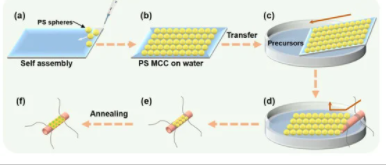Your current location:
- Home>
- Achievements>
- Research Papers
Facile Synthesis of ZnO/WO3 Nanocomposite Porous Films for High-Performance Gas Sensing of Multiple VOCs
Author: Lei Biao£»Zhang Hongwen£»Zhao Qian£»Liu Weiwei£»Wei Yi£»Lu Yanyan£»Xiao Tingting£»Kong Jinglin£»Cai Weiping
Periodical: NANOMATERIALS
Page: Volume£º13£»Issue£º4
Full text link: https://www.mdpi.com/2079-4991/13/4/733

Periodical: NANOMATERIALS
Page: Volume£º13£»Issue£º4
Full text link: https://www.mdpi.com/2079-4991/13/4/733

Volatile organic compounds (VOCs) in indoor environments have typical features of multiple components, high concentration, and long duration. The development of gas sensors with high sensitivity to multiple VOCs is of great significance to protect human health. Herein, we proposed a sensitive ZnO/WO3 composite chemi-resistive sensor facilely fabricated via a sacrificial template approach. Based on the transferable properties of self-assembled monolayer colloidal crystal (MCC) templates, two-dimensional honeycomb-like ordered porous ZnO/WO3 sensing matrixes were constructed in situ on commercial ceramic tube substrates with curved and rough surfaces. The nanocomposite thin films are about 250 nm in thickness with large-scale structural consistency and integrity, which facilitates characteristic responses with highly sensitivity and reliability. Furthermore, the nanocomposite sensor shows simultaneous responses to multiple VOCs that commonly exist in daily life with an obvious suppression sensing for traditional flammable gases. Particularly, a detection limit of 0.1 ppm with a second-level response/recovery time can be achieved, which is beneficial for real-time air quality assessments. We proposed a heterojunction-induced sensing enhancement mechanism for the ZnO/WO3 nanocomposite film in which the formation of abundant heterojunctions between ZnO and WO3 NPs significantly increases the thickness of the electron depletion layer in the bulk film and improves the formation of active oxygen species on the surface, which is conducive to enhanced responses for reducing VOC gases. This work not only provides a simple approach for the fabrication of high-performance gas sensors but also opens an achievable avenue for air quality assessment based on VOC concentration detection.
